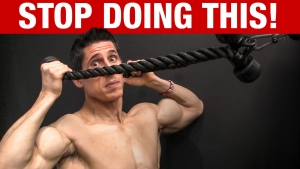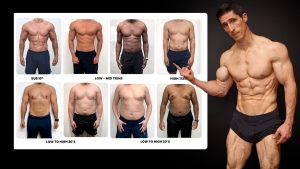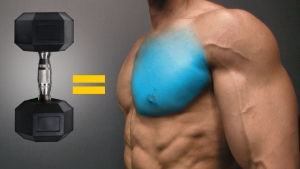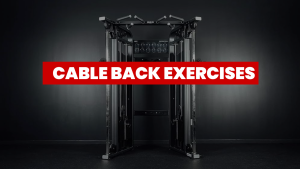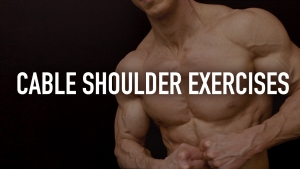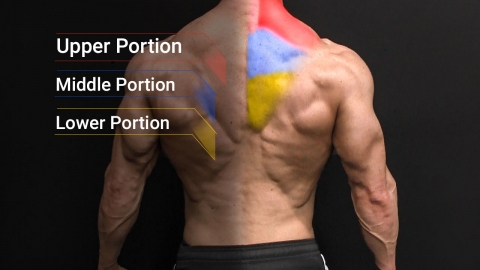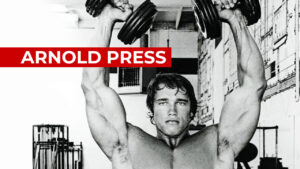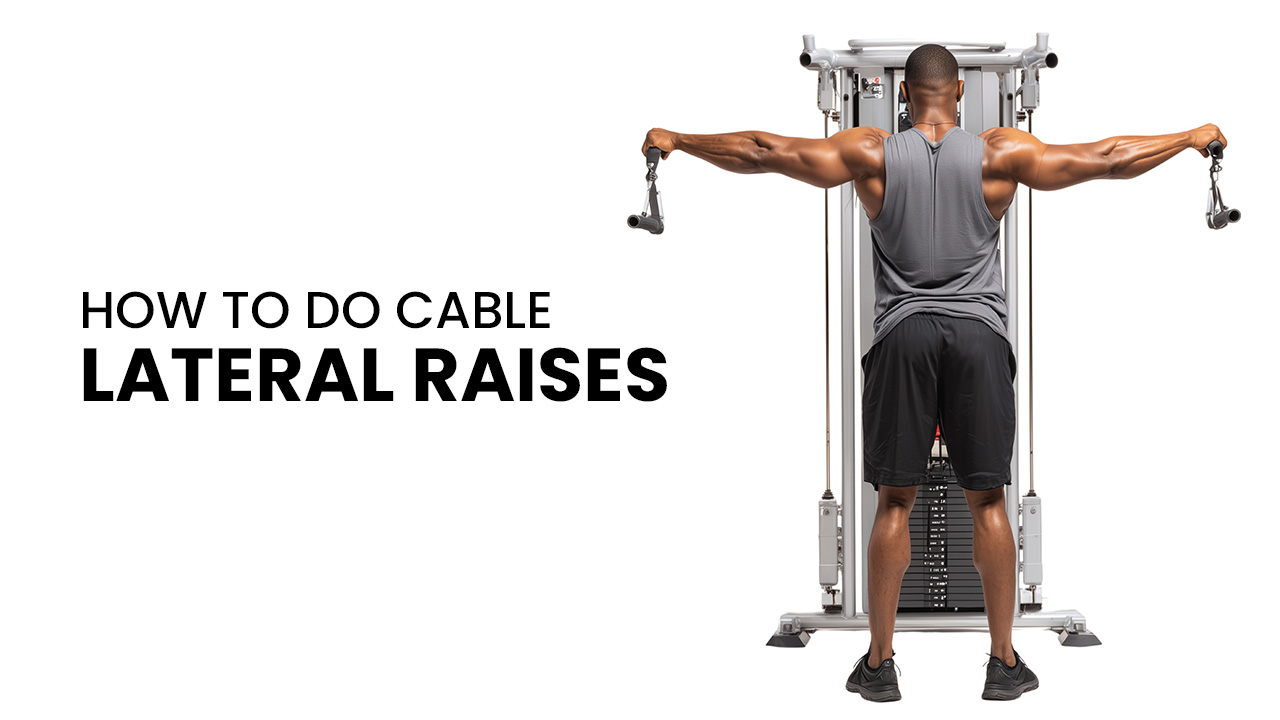
WHY do cable lateral raises?
Sure, Dumbbell Shoulder Presses are great for muscle mass, but not for the side shoulder. This requires a completely different angle and movement.
If you want that capped delt look, you have to hit the lateral deltoid muscles directly and the Cable Lateral Raise does exactly that.
Unlike the Dumbbell Lateral Raise or the Seated Lateral Raise, the cable machine keeps constant muscle tension through the full range of motion.
More consistent muscle activation means better chances for muscle hypertrophy, muscle thickness, and long-term deltoid hypertrophy.
Let’s review the muscles worked with the Cable Lateral Raise, how to do it, common mistakes, and how you can program it into your exercise routine.
CABLE LATERAL RAISES: MUSCLES WORKED
It’s not enough to just go through the motions of a Cable Lateral Raise. If you want real muscle growth, you need to know which muscles are firing and why.
That’s the foundation of a strong mind–muscle connection.
When you understand how the deltoid muscle, the rotator cuff, and the stabilizing muscles contribute, every rep becomes more intentional.
More focus equals better muscle activation, improved muscle response, and ultimately greater hypertrophy outcomes.
Here are the muscles worked by the Cable Lateral Raise:
MEDIAL DELTOID
The Cable Lateral Raise is all about the medial deltoid also called the lateral deltoid or middle deltoid.
This middle head sits on the outer portion of the shoulder, forming the round shape that gives true shoulder definition.
Its main job is shoulder abduction or lifting the arm out to the side.
Using a cable machine with a cable pulley tower keeps constant muscle activation on this muscle through the full range of motion, eliminating the “dead zone” you get with a Dumbbell Lateral Raise.
More tension across the lift means greater muscle hypertrophy, increased muscle thickness, and long-term deltoid hypertrophy.
SUPRASPINATUS
At the bottom of the rep, the supraspinatus, one of the rotator cuff muscles, helps initiate the first few degrees of shoulder abduction.
This small muscle sits deep at the top of the shoulder and works to “kick-start” the movement before the lateral head of the deltoid takes over.
By training with cables, you ensure consistent muscle response here as well, improving joint stability and preventing muscle imbalances that can come from relying only on presses like the Dumbbell Shoulder Press or Frontal Raises.
TRAPEZIUS
The upper traps act as stabilizing muscles during the Cable Lateral Raise. They help control the scapula and keep the shoulder joint steady.
Too much shrugging, however, shifts load away from the delts. Keeping the shoulders down ensures the traps support without dominating.
This balance enhances overall muscle strength and reduces the risk of overcompensation in the upper back.
HOW TO DO CABLE LATERAL RAISES
The Cable Lateral Raise is one of the most precise ways to target the lateral deltoid.
Unlike Dumbbell Raises, the gym cable machine provides a resistance profile that matches the length-tension relationship of the delt more closely.
That means steady muscle activation patterns and a better chance of driving real lateral deltoid hypertrophy.
Here’s how to set it up and perform it correctly:
CABLE LATERAL RAISES

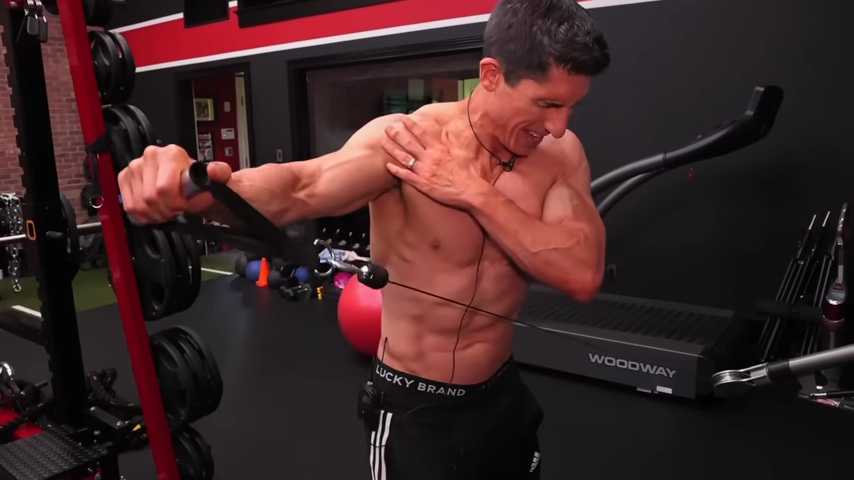
HOW TO DO CABLE LATERAL RAISES:
- Adjust the pulley machine so the cable pulley and single grip handles are just below hip level. Clip on a single hand cable attachment. This low setup gives you a pre-stretch on the deltoid and avoids the dead zone you’d experience with free weights.
- Stand sideways to the stack. If you’re training your right shoulder, keep the cable machine on your left side. Grab the handle with your left hand and pass it across your body so the working arm starts slightly in front. That forward position lengthens the delt, engaging more muscle regions from the start.
- Keep your feet shoulder-width apart, knees softly bent, chest tall, and core braced. Think about stability first. This prevents your anterior deltoids, posterior deltoids, or other muscle groups from compensating for the movement.
- With a slight bend in the elbow, raise your arm out to the side. Lead with the elbow, not the hand. That simple adjustment shifts the load directly onto the proximal deltoid and distal deltoid fibers instead of your traps. Keep your wrist neutral the entire way.
- Stop when your arm reaches shoulder height or parallel to the floor. That’s where the delt is fully engaged. Going higher turns it into shoulder adduction/abduction ROM dominated by the traps.
- Control the way down. No swinging, no leaning, no momentum. Slow eccentrics here like an Eccentric Lateral Raise increase time under tension and improve hypertrophic outcomes.
WHAT MAKES IT EFFECTIVE: By maintaining constant load, the cable creates better muscle architecture adaptations and may even improve fascial thickness and musculotendon properties compared to dumbbells. For resistance-trained men and women, training with strict form and sufficient repetition volume has been shown to maximize growth. This means more efficient resistance training, improved training duration, and long-term deltoid hypertrophy.
CABLE LATERAL RAISES: COMMON MISTAKES
The Cable Lateral Raise looks simple, but the details make or break it.
A slight shrug, an arm too straight, or even rushing the rep can shift the load away from the delt and onto other muscle groups.
That means less growth where you want it.
To get the most from this shoulder exercise, you need to know the common breakdowns in form, what they do to your muscle activation patterns, and the exact fixes that keep the tension locked on the side delt.
SHRUGGING THE WEIGHT
As soon as the handle starts moving, a lot of lifters elevate the shoulder and shrug. The traps jump in, taking over the load, while the delt does less work.
This alters the length-tension relationship of the movement and wastes the part of the rep that should be targeting the lateral deltoid.
Over time, you’ll build bigger traps while your shoulders stay flat. Worse, you’ll create muscle imbalances between the upper back and the delts.
Keep the shoulders “packed down” away from your ears. Think of pushing your arm out to the side, not up.
This small shift keeps tension on the delt where it belongs and maximizes the chances for lateral deltoid hypertrophy.
KEEPING THE ARMS STRAIGHT
Locking the elbow into a perfectly straight line turns the lift into a long-lever exercise that stresses the joint more than the muscle.
The delt has to fight poor leverage throughout the rep, and the elbow joint ends up taking more stress than necessary.
You’ll experience muscle fatigue early and never push the delt close to momentary failure.
Maintain a soft bend (about 10 to 15 degrees) in the elbow. This shortens the lever just enough to keep the joint safe and lets the delt drive the movement.
USING MOMENTUM
Swinging the torso or leaning away from the stack to “help” the handle up. But the moment you use momentum, the delt isn’t loaded in the way it should be.
You’re not training the shoulder. You’re just moving weight from A to B. The result is less tension on the muscle and fewer hypertrophic outcomes.
Drop the weight and slow down. Each rep should be strict and controlled, especially on the eccentric. You want to feel the delt working through the full range of motion, not your torso doing the lifting.
CUTTING THE ROM SHORT
Many lifters stop before reaching shoulder height because the last part of the raise feels difficult.
The top portion of the rep is where the delt experiences peak tension. Cutting it short reduces effective training volume, limits muscle response, and slows down gains in muscle thickness.
Lift until your arm is parallel to the floor. That’s shoulder level or the point where the lateral deltoid is fully activated. Control the descent and repeat.
IGNORING VARIATIONS
Finally, you shouldn’t focus exclusively on performing the standard raise, never changing cable position, handle type, or angle.
The delt is made up of different muscle regions. Sticking to one variation limits growth and can slow progress, especially for lifters with an advanced training status.
Rotate in new challenges.
Try the Behind the Back Cable Lateral Raise to hit the delt in a lengthened position, a Dead-Stop Lateral Raise to eliminate momentum, or Elevator Lateral Raises for added time under tension.
Pair these with accessory moves like the Cable Face Pull for posterior delt balance.
Changing angles and cable attachments keeps progress moving and improves overall shoulder development.
CABLE LATERAL RAISE VARIATIONS
Small changes in how you perform a lateral raise can completely alter the way the shoulder works.
Adjusting the angle of your arm or the way resistance is applied changes the length-tension relationship, shifts muscle activation patterns, and creates new opportunities for deltoid hypertrophy.
Understanding these variations helps you match the exercise to your training goal whether it’s increasing training volume, reaching failure more efficiently, or simply keeping progress moving when standard raises start to stall.
Here are the exercises you can pair with cable lateral raises in your next shoulder workout to hit the delts from every angle.
BENT-ARM CABLE SIDE RAISE

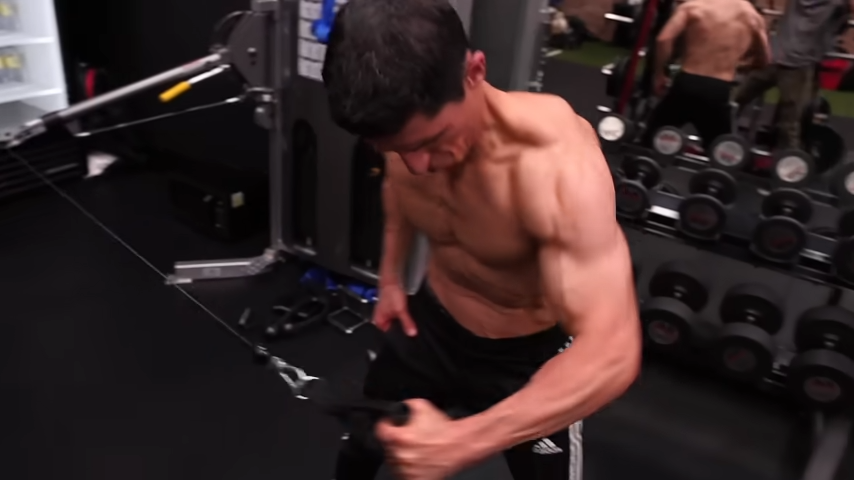
HOW TO DO THE BENT ARM CABLE SIDE RAISE:
- Attach a single handle to the low pulley of a cable stack. Stand sideways to the machine with your feet shoulder-width apart and grab the handle with the outside hand.
- Let your arm cross slightly in front of your body to put the delt on stretch before you even start.
- Keep a bend in the elbow. Locked arms make this harder on the joints and easier to cheat.
- Brace your core, chest tall, and keep the rest of your body locked in. From that stretched position, lift your arm out to the side, leading with the elbow instead of the hand.
- Stop when your arm is parallel to the floor. That’s where the delt is doing its job.
- Pause briefly to make sure the shoulder, not the trap, is carrying the load.
- Then lower the handle slowly, resisting the weight all the way down. The controlled eccentric doubles the benefit of each rep.
WHAT MAKES IT EFFECTIVE: The bent-arm position shortens the lever, letting you use a bit more weight while still keeping strict form. Combine that with the constant tension of the cable, and you’ve got one of the most effective ways to load the side delt through its full working range.
BENT ARM SIDE RAISE

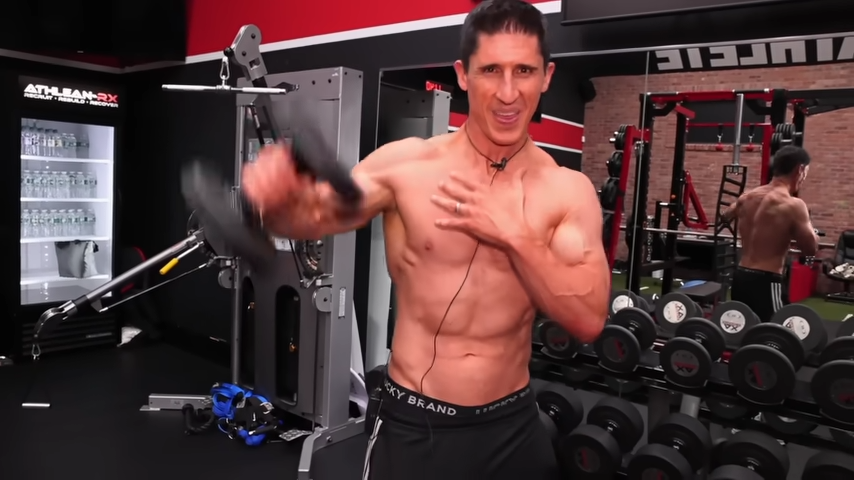
HOW TO DO THE BENT ARM SIDE RAISE:
- Stand tall with your feet about shoulder-width apart and a pair of dumbbells at your sides.
- Choose a heavier load than you’d normally use for a Straight-Arm Raise. The bent elbow shortens the lever, so you can safely go up in weight.
- Keep your chest tall, core braced, and your body locked in to remove momentum from the equation.
- With a bend in your elbows, lift the dumbbells out to the sides until your arms are at shoulder height. Think “elbows lead, hands follow.”
- Keep your thumbs slightly higher than your pinkies to avoid internally rotating the shoulder.
- Your wrists and hands should stay stacked just above the elbows. This keeps the rotator cuff protected and prevents the anterior deltoid from taking over.
- At the top, your elbows can drift just slightly behind your torso to keep tension locked on the lateral delts.
- Slowly lower the weights back down under control.
WHAT MAKES IT EFFECTIVE: The bent-arm position gives you leverage to handle more weight while still keeping the focus on the side delt. Done correctly, this variation minimizes stress on the rotator cuff, keeps the traps from dominating the lift, and allows you to load the shoulders safely with enough resistance to spark growth.
STRAIGHT-ARM LATERAL RAISE

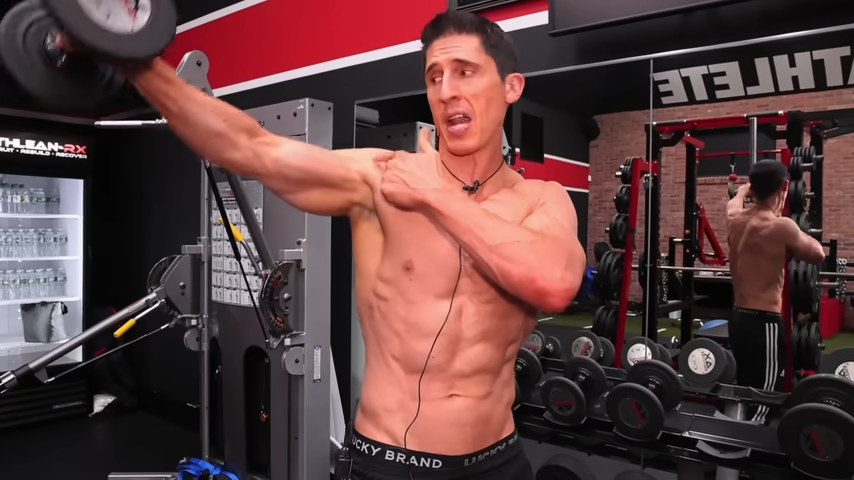
HOW TO DO THE STRAIGHT ARM LATERAL RAISE:
- Stand tall with your feet shoulder-width apart and a pair of light dumbbells at your sides. Use a neutral grip with palms facing in.
- Keep a soft bend in the elbows (not locked) and brace your core so the rest of your body stays stable throughout the set.
- Lift both arms out to the sides until they reach shoulder height, keeping that slight bend in the elbows the entire way.
- Think of your arms moving like the wings of a plane: smooth and controlled. Focus on driving the motion through the lateral deltoids, not by swinging your torso or using momentum.
- At the top, pause briefly to lock in tension, almost like a mini Dead-Stop Lateral Raise, before lowering back down under control.
WHAT MAKES IT EFFECTIVE: With the arms kept straighter, the lever is longer, which puts more direct tension on the side delt. This makes the exercise more challenging, even with lighter weight. Done properly, it builds strength and definition in the lateral head of the deltoid while reinforcing strict form and control. If you don’t have dumbbells, resistance bands can be used to mimic the same pattern.
CABLE LATERAL RAISES: PROGRAMMING & PROGRESSION
You can have perfect form and training efforts on the Cable Lateral Raise, but if the programming is off, you won’t see the full extent of the results you want.
The delt responds to the right mix of training variables including training volume, intensity, and progression. Here’s how to structure this exercise into your workout.
SETS, REPS, AND VOLUME
For most lifters, the sweet spot for the cable lateral raise is 3 to 4 working sets of 10 to15 reps.
This range provides enough load to drive growth while still letting you keep strict form.
Lifting too heavy turns the movement into a trap shrug or a momentum swing, and that takes the tension off the lateral deltoid where you want it most.
The key is to choose a weight that gets you close to failure in the last couple of reps.
If you can breeze through all 15 reps with perfect form, the weight is too light. If you can’t get past 7 or 8 reps without relying on momentum, it’s too heavy.
That balance is what stimulates muscle activation and keeps progress moving forward.
As far as frequency is concerned, most people will see the most muscle size by training the side delt twice per week. But that doesn’t mean doing 20 sets every session.
It means sprinkling in well-programmed volume across your push or shoulder days.
Think of Lateral Raises as a precision tool: consistent use over time builds results, while overdoing them only eats into recovery.
PLACEMENT IN A SHOULDER WORKOUT
The order of exercises matters. Heavy compound presses, overhead lifts, and dumbbell shoulder exercises should always come first.
That includes exercises like the Barbell Overhead Press, Dumbbell Shoulder Press, Arnold Press, Dumbbell Shoulder Raise, or even Push Press.
These big lifts move the most weight, hit multiple muscle groups, and require maximum energy and stability.
If you pre-fatigue the delts with isolation work too early, your pressing strength will drop, and overall shoulder development will suffer.
Once the compound exercises are out of the way, that’s when you can focus on the Cable Lateral Raise.
At this point, the delts are already working, and isolation drills let you finish them off with strict tension.
Positioning lateral raises here ensures the lateral deltoids get the spotlight without interference from stronger movers like the anterior delts or triceps.
PROGRESSION STRATEGIES
Progression doesn’t always mean piling more weight on the stack. The Cable Lateral Raise is an isolation movement, and the delts respond best to smart, controlled overload.
Here are the most effective ways to keep progressing:
Load Progression: Yes, you can increase weight but do it gradually. Add small jumps while keeping form locked in. If the added load forces you to swing or shrug, you’re no longer training the delts.
Rep Progression: Stay within the 10–15 rep range. If you can easily hit 15 strict reps, that’s the signal to move up in weight.
Eccentric Focus: The lowering phase is where a lot of growth happens. Take 3 to 4 seconds to return the handle back down. That controlled eccentric increases time under tension, boosts muscle activation, and is one of the safest ways to progress without having to go heavier.
Pause Reps: Holding for 1 to 2 seconds at the top forces the delt to stay under tension in its most challenging position. This not only improves the mind–muscle connection but also prevents you from relying on momentum to finish the rep.
Advanced Methods: For lifters with more experience, intensity techniques can push past plateaus. Drop sets extend the set once you’ve hit failure by lowering the weight and continuing strict reps. Rest–pause lets you squeeze out a few more reps after a short break.
The Cable Lateral Raise isn’t about how much weight you can move. It’s about keeping tension on the right muscle from start to finish.
By dialing in form, using the right variations, and progressing with control, you make every rep count toward building stronger, more balanced shoulders.
If you treat this lift as more than just a complementary exercise, it becomes one of the key drivers of complete shoulder development.
Check out our complete line of ATHLEAN-RX Supplements and find the best training program for you based on your fitness level and goals.

- The Cable Lateral Raise keeps constant tension on the lateral deltoid through the full range of motion, maximizing muscle activation where dumbbells fall short.
- Here’s how to perform the Cable Lateral Raise:
- Drop the cable to just below hip height and clip on a single handle. This low setup gives the delt a stretch from the start.
- Stand sideways to the stack. Training the right shoulder? The machine goes on the side of your left arm. Grab the handle attachment and bring it across your body so the working arm starts slightly in front.
- Feet shoulder-width, knees bent, chest tall, core braced. Lock the body down so the lateral delts do the lifting, not the front delts, rear delts, or any other helpers.
- Keep a soft bend in the elbow and lift the arm out to the side. Lead with the elbow, not the hand. This keeps the load squarely on the delt fibers instead of dumping it into the traps. Wrist stays neutral.
- Raise the cable handle parallel to the floor. Higher than that, and the traps start stealing the work.
- Lower the handle slowly. No swinging and no leaning. Really focus on the eccentric phase of the exercise.
- Program the cable lateral raise for 3 to 4 sets of 10 to 15 reps, placing it after your heavy pressing work so you can isolate the lateral deltoids with strict form and take them close to failure without sacrificing control.
CABLE LATERAL RAISES FAQ
Absolutely. The Cable Lateral Raise is one of the most effective ways to hit the lateral head of the deltoid.
Unlike dumbbells, cables provide constant tension from the bottom to the top of the lift, which means the muscle never gets a break.
That steady load is what drives muscle activation, improves the mind–muscle connection, and ultimately leads to better growth.
If your goal is capped shoulders and balanced delt development, cable lateral raises should be a staple in your program.
Form is everything here. Start with the pulley machine set just below hip height and clip on a single handle.
Stand sideways to the stack and grab the handle with the outside hand, letting your arm cross slightly in front of your body for a natural pre-stretch.
Brace your core, keep your chest tall, and lock the rest of your body in place.
Lift the arm out to the side with a soft bend in the elbow, leading with the elbow, not the hand. Stop at shoulder height.
Lower the handle slowly to take advantage of the eccentric. If you can’t control the weight without swinging or shrugging, it’s too heavy.
Your stance should be stable and locked in. Feet shoulder-width apart, knees slightly bent, and core engaged.
This prevents your torso from swaying and stops the anterior deltoids or traps from jumping in to cheat the movement.
Some lifters like to lean slightly away from the stack to increase the stretch at the bottom and that’s fine, but the key is keeping the body still while the working arm moves.
A solid stance ensures all the tension stays on the lateral deltoid, which is the whole point of the exercise.
REFERENCES
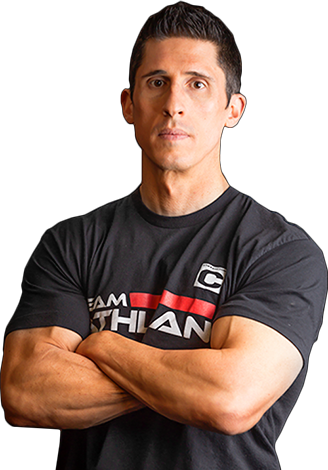
Jeff Cavaliere M.S.P.T, CSCS
Jeff Cavaliere is a Physical Therapist, Strength Coach and creator of the ATHLEAN-X Training Programs and ATHLEAN-Rx Supplements. He has a Masters in Physical Therapy (MSPT) and has worked as Head Physical Therapist for the New York Mets, as well as training many elite professional athletes in Major League Baseball, NFL, MMA and professional wrestling. His programs produce “next level” achievements in muscle size, strength and performance for professional athletes and anyone looking to build a muscular athletic physique.
